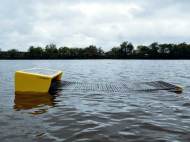Seaswarm – autonomous oil-absorbing robot from MIT
 Researchers at MIT have created a robotic prototype that could autonomously navigate the surface of the ocean to collect surface oil and process it on site. The system, called Seaswarm, is a fleet of vehicles that may make cleaning up future oil spills both less expensive and more efficient than current skimming methods. It uses a conveyor belt covered with a thin nanowire mesh to absorb oil.
Researchers at MIT have created a robotic prototype that could autonomously navigate the surface of the ocean to collect surface oil and process it on site. The system, called Seaswarm, is a fleet of vehicles that may make cleaning up future oil spills both less expensive and more efficient than current skimming methods. It uses a conveyor belt covered with a thin nanowire mesh to absorb oil.
The Seaswarm robot, which is 4.86 meters (16 feet) long and 2.13 meters (7 feet) wide, uses two square meters of solar panels in order to generate energy for its propulsion. With just 100 watts, the equivalent of one household light bulb, it could potentially clean continuously for weeks.
As the head moves through the water the conveyor belt constantly rotates and sucks up pollution. The nanowire-covered belt is then compressed to remove the oil. As the clean part of the belt comes out of the head it immediately begins absorbing oil, making the collection process seamless and efficient.
The fabric, developed by MIT Visiting Associate Professor Francesco Stellacci, is able to absorb up to twenty times its own weight in oil while being hydrophobic. By heating up the material, the oil can be removed and burnt locally and the nanofabric can be reused.
“Unlike traditional skimmers, Seaswarm is based on a system of small, autonomous units that behave like a swarm and ‘digest’ the oil locally while working around the clock without human intervention,” explained Senseable City Lab Director Carlo Ratti.
Using swarm behavior, the units will use wireless communication and GPS and manage their coordinates and ensure an even distribution over a spill site. By detecting the edge of a spill and moving inward, a single vehicle could clean an entire site autonomously or engage other vehicles for faster cleaning.
“We hope that giant oil spills such as the Deepwater Horizon incident will not occur in the future, however, small oil leaks happen constantly in off shore drilling”, Ratti said. “The brief we gave ourselves was to design a simple, inexpensive cleaning system to address this problem.”
MIT researchers estimate that a fleet of 5,000 Seaswarm robots would be able to clean a spill the size of the gulf in one month. The team has future plans to enter their design into the X-Prize’s $1 million oil-cleanup competition. The award is given to the team that can most efficiently collect surface oil with the highest recovery rate.
Senseable City Lab’s initial Seaswarm prototype will be unveiled at the Venice Biennale’s Italian Pavilion on Saturday, August 28. Visitors will be able to interact with the prototype and view a video on how the vehicle was constructed and how it operates. The Venice Biennale runs from August 29 to November 21, 2010.









Leave your response!